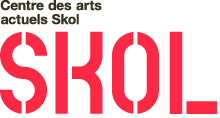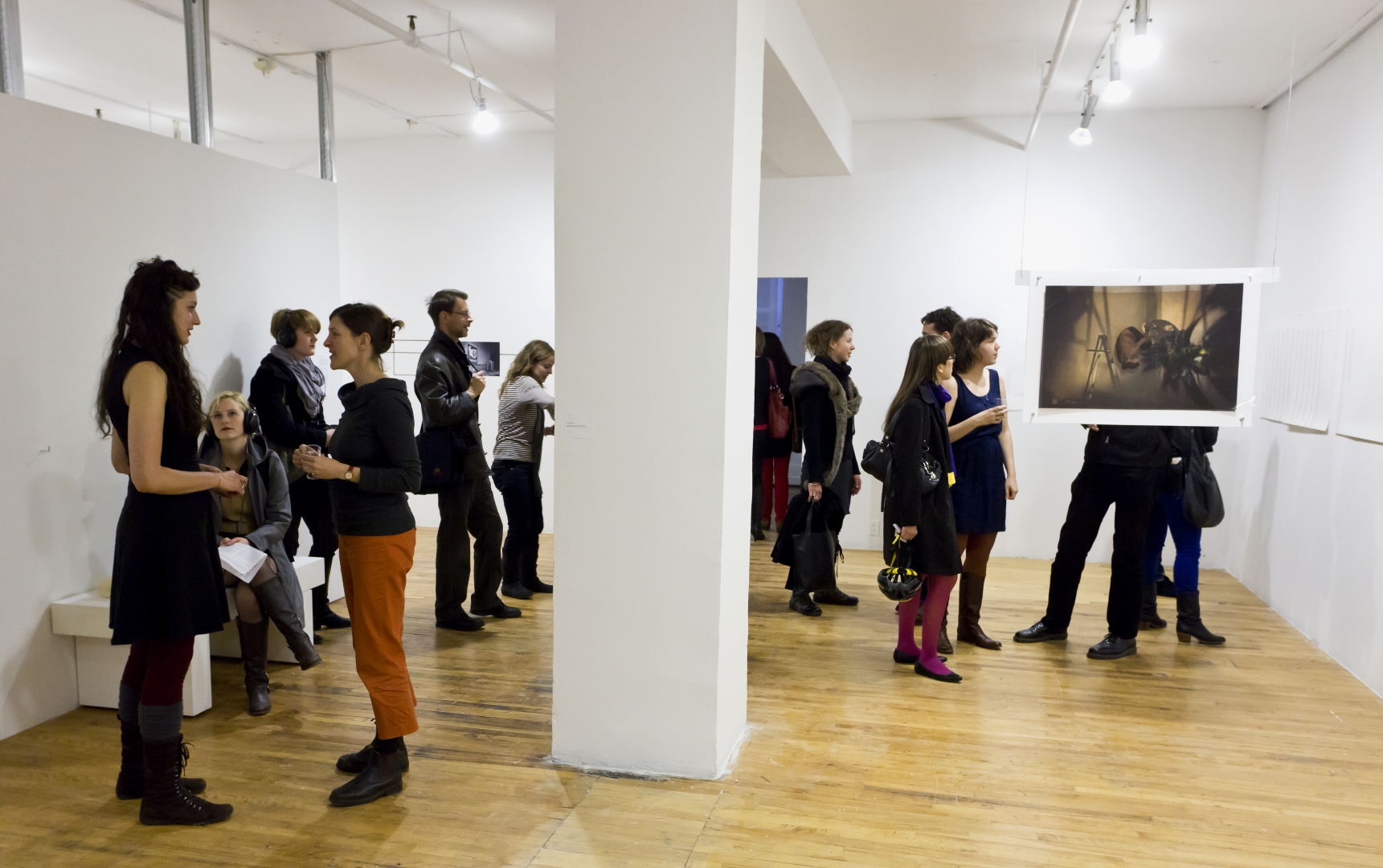Embracing the Archive
Exhibition
November 4 – December 17, 2011
Opening on Friday November 4, 5pm-9pm
Performance by Adriana Disman on Saturday November 5 at 3pm
Project Description
Mark Clintberg, Adriana Disman, Ève Dorais, Rebecca Duclos, Kandis Friesen, Emmanuel Galland, Denis Lessard, Pilar Macias, Natalie Olanick, Anne-Marie Proulx, Sabrina Russo, Lorraine Turci and Anne-Sophie Garcia bring perspective to Skol’s 27-year history, complicating one’s perception of a homogeneous, linear trajectory. Documents, artifacts, images pulled from the newly processed historical archive reveal surprising cultural and disciplinary shifts as well as commonalities across generations, including the launch of the as-yet unpublished History of Skol by former board member Yves Théoret, annotated by current members Sabrina Russo and Anne-Marie Proulx.
Mark Clintberg
My Debt (2011) is an epistolary project generated by Mark Clintberg in response to the archives of Skol. Through a process of careful research through Skol’s files, the artist locates names of other artists, curators, institutions, and writers whom he feels indebted to. These debts – in relationship to the materials held in Skol’s archive – form the subject of a series of letters then written by the artist. The original copies of these letters are inserted into the archive along with or next to the file of their addressee. Visitors to Skol are invited to take poster-copies of the letters to read at their leisure and to display. At the conclusion of the project, the original handwritten letters will be mailed to the individual or institution they are addressed to along with a short text explaining the project. In cases where the addressee is deceased, letters will be sent to that individual’s estate.
Adriana Disman
In Correspondence Dossier GAYER, JOHN 1985-89 Adriana Disman will conduct an experimental investigation and performance responding to archival material, an investigation into the process of subjective embodiment as responding to images from an outside source. The source material for this work will be composed of images and text found in a singular file from Skol’s archives: Correspondence Dossier GAYER, JOHN 1985-1989. One layer of process in this exploration will be the sharing of a performance with the public. Primarily active in a solo performance art practice, Disman has created mainly durational, one-to-one works. Exploring the fluidity of identity, the creation of liminal space, and the shifting border between passivity and action, her work focuses on the corporeal and immaterial interaction between bodies when normative social constructs are altered or removed. In the past, Disman has created simple situations in which the outcome is unknown and determined by the participant who is given a written invitation upon entering the space and encountering the artist blindfolded. Some of the invitations have included inviting the participant to “kiss the artist”, “place your hands anywhere on my body”, “lay with me in bed and tell me the story of how I will die”, and to “enter this sewing needle anywhere in my skin.” Disman explores the thresholds of vulnerability as a catalyst for intimacy and intimacy as a catalyst for transformation. She uses her practice as a way to embrace her fears and confront a human loneliness.
Ève Dorais
Artists mindful of their historical heritage may well ask themselves “What more can I add?” To which Ève Dorais would reply: “critical meaning, re-readings of history—not of famous artists we only know about through books, the Internet, and retrospectives; no, rather a history of exhibitions of works currently being produced, that we have personally experienced.” or “The archives. Here’s the thing. You have to be objective. Not touch the materials with your hands. Methodically reprocess the information. Never contradict yourself. Say nothing. Obey and fill out forms. Above all, never a crooked or uncertain line. Precision.”
Rebecca Duclos
Rebecca Duclos is interested as much in what is said as what is not said within the traditional formulary of a gallery proposal. More specifically, she has been researching how arts practitioners choose to (if they do) articulate the more oblique and often intuitive moments that initiate or sustain an idea that demands to be materialized as an artwork.She would like to use this research opportunity to think about how the engagement and articulation of para-academic practices creates a discursive space for arts practitioners to acknowledge the complex (and legitimate) potential that forces such as chance, synchronicity, association, intuition, and luck have upon their research and their practice. She is distinctly interested in whether, through the cracks of the well-packaged, formal gallery proposal and its implied expectations of linearity and sequentiality, artists are able to hint at the more complex and processual emergence of their projects.
Kandis Friesen
Marked on the pages within SKOL’s archived files and folders are small hand-written drawings and texts: incidental sketches, scratches, doodles, and footnotes, in ink, pencil, and marker, made by the hands of the people who have worked at SKOL over its twenty-seven year history. From jury committees to staff notes, these papers are marked with repetitive drawings, circling nothing, underlining everything, making visual notes that mark some kind of personal code, made to remind, remember, distract or emphasize. Through scanning and reconfiguring these hand-made marks, Kandis Friesen will create a new drawing, suggesting a new visual archive of marks and texts, a new set of ‘documents’ to be arranged and organized into a new composition. Brought together, these incidental drawings contribute a gestural and textured aspect to the text-based records that Skol’s archives hold.
Emmanuel Galland
Using an accounting analysis pad, Emmanuel Galland reviews the yearly programming archive since Skol’s beginnings. Like in a jury or a selection committee, lists of real names form a roster of known and unknow artists, mainly Quebecers and Canadians. What question determines the options encountered on each page: YES / NO / MAYBE? What random order underlies such an interpretation, revision, reevaluation, validation, or rejection? The information found in this pad decays, like a grain of salt, this survey of Skol’s data. YES / NO / MAYBE – Compte d’apothicaire (a great deal of fuss over nothing of importance) makes light of what’s IN and what’s OUT, of trends, of long forgotten artists as much as of artists who were never chosen, and who are obviously nonexistent in the archive (the dejected).
Denis Lessard
Last August, Denis Lessard, assisted by Aldis Snorradóttir, finished processing Skol’s historical archive. Throughout the exhilarating six-month-long adventure, he turned up hidden treasures and intriguing curiosities. Lessard here presents his archivist’s selections, grouped under a few loose headings: founding documents, recognizing oneself in the archives, buried artwork, mobilization and issues. The documents on display may vary over the course of coming weeks. This contribution is dedicated to the memory of citizen artist Philippe Côté (1957-2011).
Pilar Macias
Pilar Macias dwells on the paradox of representing movement through figurative photography that shows what one doesn’t readily see in the shot itself. Acetate transparencies and projected images are combined with the initial photo, forcing us to move around and observe as something else appears, prompting doubts about the situation, about the real. Didi Hubermann said of the photograph that it is always related “to what precedes and follows it.”1 Macias here is exploring photography both as picture-taking medium and as story-telling image. She works with physical and atmospheric tensions and with the expressive potency of transpositions and transparencies. She attempts to render the tension between the capture of a particular reality and the hybrid presence emanating from biographical and fictional givens.
Natalie Olanick
The selected pieces for Natalie Olanick’s exhibition come from a subjective reaction to the diversity of media documented in Skol’s archives. She approached the archive as an artist looking at the production of other artists, chosen by artists. Her attention was on the processes artists have used to produce meaning. The time periods that are characterized by particular art production play a part in the structure of describing works. However, the time difference acts as a tool rather than a goal for revealing issues that artists were considering. The approach to both narrative and abstraction in painting of the mid to late 80s, the continued exploration of photography and time based works of the early 90s, to identity issues and social commentary of the late 90s early 21st century are all vital streams of art making that still have currency. The comparison of samples from the archives will create an overlap of issues. The viewer can notice common themes, techniques or vastly different beliefs.
Anne-Marie Proulx
While a artist-consultant of the Office for Archival Review during the summer of 2009 SKOOL program, Anne-Marie Proulx examined Skol’s archive boxes in order to extract every name encountered. Well known and lesser known names appear one after the other, in no particular order. Associations are made between the names and persons, without ever revealing the why their names appear in the first place. This Collection of names attempts to trace the passage of individuals in Skol’s paper archive as much as it is an invitation to ask oneself what it means to belong there.
Lorraine Turci
Corrupt file, corrupt archives: there is no innocent archive. To choose a memory is in some sense to appropriate it: selected, inscribed and excluded, the initiative is marked by authority and power—over the future as much as over the past. Handling it invites imprecision, instability; it is to reactivate a memory. The digital archive raises another issue: digital permanence. Digital data depends both on its highly fragile media and on decoding procedures: devices and software whose disappearance would make it unreadable. In Données (Data) artist Lorraine Turci takes us on a visual tour of Skol’s digital archive, manipulating (and playing with) administrative documents, photographs, website code, all brought together by their insubstantiality. Beyond examining the interpretation of the archive, Données indirectly interrogates the conservation of documents destined to a foretold disappearance.
















